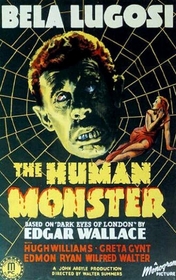Our editor-in-chief Nate Yapp is proud to have contributed to the new book Hidden Horror: A Celebration of 101 Underrated and Overlooked Fright Flicks, edited by Aaron Christensen. Another contributors include Anthony Timpone, B.J. Colangelo, Dave Alexander, Classic-Horror.com's own Robert C. Ring and John W. Bowen. Pick up a copy today from Amazon.com!
The Dark Eyes of London (1940)
Dark Eyes of London, or The Human Monster is one of those movies that are stuck between one genre and the other. It, like many other low- budget thrillers from the 1930’s, is a mix of the horror and mystery genre. The plot is far more intricate than most films of its ilk.
The plot concerns the sinister Dr. Orloff (Bela Lugosi), who seems to be a philanthropic insurance salesman. In reality, he is using a nearby home for the blind as a base for his evil schemes. Dr. Orloff is using the poor residents of the home in his plots to kill wealthy members of society. Once the men are killed off, Orloff collects the insurance money through a series of forgeries and insurance fraud. His blind henchman Jake (Wilfred Walter) is a human gargoyle that does much of Dr. Orloff’s dirty work. Caught up in Orloff’s web of crime are three characters right out of the classic horror film textbook: the beautiful victim’s daughter Diana (Greta Gynt), the straight-laced Inspector Holt (Hugh Williams), and the brash American police Lieutenant O’Reily (Edmond Ryon). The film ends predictably, but there is a nice little twist right at the climax.
The film is slightly more realistic than most horror films. Insurance fraud isn’t exactly as wacky as constructing a death ray or making a monster out of body parts. Dr. Orloff’s plan may be more sophisticated than your average mad genius, but it is far more boring. Dark Eyes of London is a paradoxical film: its complex plot sets it apart from other films, but it also makes it inferior.
The film's sets aid the cast and the script in making Dark Eyes of London one of the most yawn-inducing horror films of all time. The sets are either drab office buildings or grubby looking workhouses. Even Lugosi’s laboratory is boring looking. The film’s graininess doesn’t help either. Dark Eyes of London resembles the muck that Lugosi drowns his victims in.
Lugosi is the saving grace of the film. In an ocean of stereotypical, mind staggeringly boring characters he is the saving grace. Sure, he isn’t doing anything new. He’s played evil men misleading disabled men before in The Raven (1935), as the demonic Dr. Vollin who uses the disfigured Edmund Bateman, and in Son of Frankenstein, as the revenge maddened Ygor who employs the monster as his tool of revenge. Lugosi’s turn as Dr. Orloff isn’t as enjoyable as those other roles, but he still has a few genuinely “Lugosi-ish” moments. One of the most memorable scenes is where Lugosi deafens a blind man who had betrayed him.
Dark Eyes of London is one of three British films Lugosi made. The others are Mystery of the Mary Celeste and Mother Riley Meets the Vampire. For more information on these three films plus Lugosi’s 1951 Dracula stage tour of the British Isles read "Vampire Over London- Bela Lugosi in Britain" by Frank Dello Stritto and Andi Brooks {and read Classic-Horror's interview with Dello Stritto - ed.}. The book is meticulously researched and is very well written. "Vampire Over London- Bela Lugosi in Britain" is an extremely entertaining look into a very misunderstood period of one of Hollywood’s most misunderstood stars.
Dark Eyes of London is recommended to die-hard Lugosi fans only. Even if you really like most classic horror films you might not like this one. I was bored by 85% of the film. Lugosi manages to get in some great moments in, but Dr. Orloff is far less interesting than many of his other characters. My advice is to watch White Zombie, Return of the Vampire, Dracula, The Raven, Son of Frankenstein, or even The Devil Bat instead.








